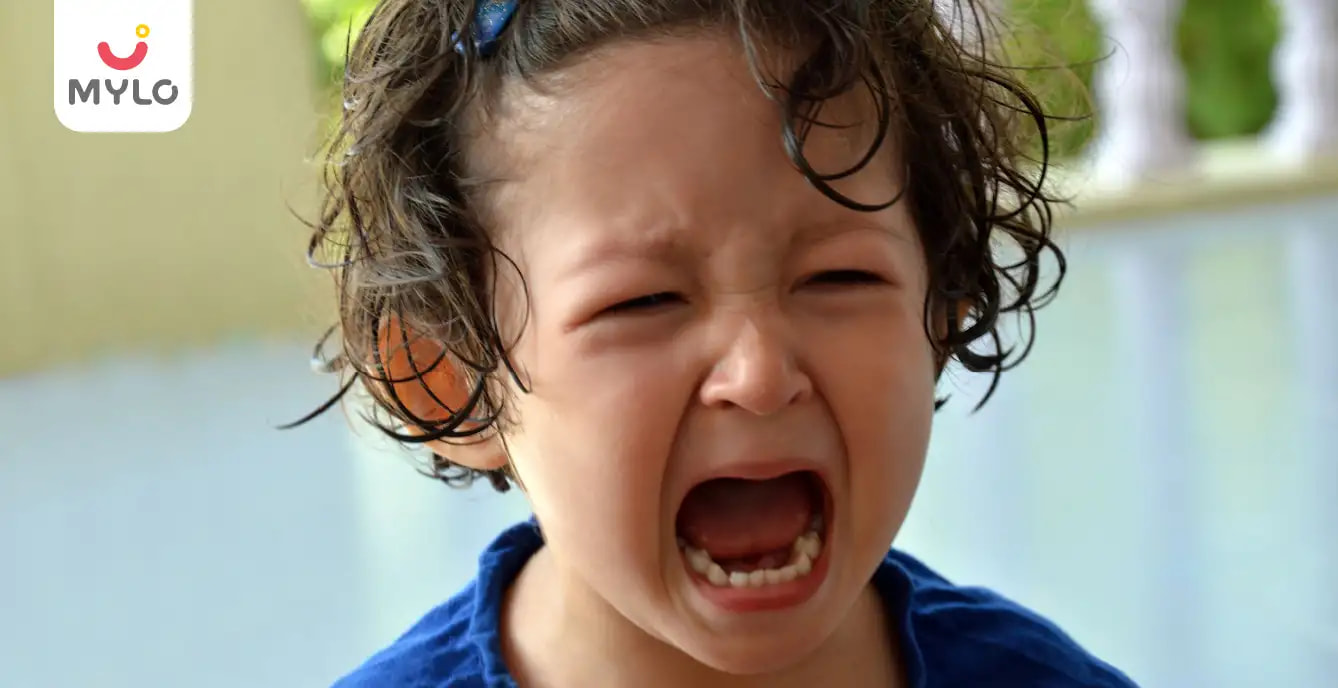Home

Illnesses & Infections

Vulvovaginitis in Toddlers Causes, Symptoms and Treatment
In this Article

Illnesses & Infections
Vulvovaginitis in Toddlers Causes, Symptoms and Treatment
Updated on 3 November 2023
Vulvovaginitis is a common condition that affects toddlers, causing swelling and irritation of the vulva and vagina. It can be uncomfortable and even painful for your child, and can lead to other health issues if left untreated.
In this article, we’ll discuss what vulvovaginitis in toddlers is, what causes it, its symptoms, how it’s diagnosed, possible treatments, home remedies, and how to prevent it.
What is Vulvovaginitis in Toddlers?
Vulvovaginitis is a condition that causes inflammation of the vulva and vagina in young children. It is most common in children between the ages of 2-5 years old but can occur in toddlers as young as one year old. It is caused by an infection of the vagina or vulva caused by bacteria, yeast, or viruses.
The vulva is the outermost part of the female reproductive system and is made up of the labia majora and labia minora. The vagina is the innermost part of the reproductive system and is connected to the uterus. The vagina is a mucous membrane and is prone to infections due to its moist environment.
What Causes Vulvovaginitis in Toddlers?
The cause of vulvovaginitis in toddlers can vary depending on the underlying condition.
1. Bacterial infections
Bacterial infections, such as group A streptococcus or Escherichia coli, are the most common cause of vulvovaginitis in toddlers. These infections can be caused by contact with contaminated objects, such as unwashed toys, or by contact with other children who have the infection.
2. Yeast infections
Yeast infections are another common cause of vulvovaginitis in toddlers. Yeast infections are caused by an overgrowth of a naturally occurring fungus called Candida albicans. Yeast infections can be caused by a variety of factors, including poor hygiene, the use of antibiotics, or a weakened immune system.
3. Viral infections
Viral infections, such as the herpes simplex virus, can also cause vulvovaginitis in toddlers. This type of infection is usually caused by sexual contact and is more common in older children.
4. Allergic reaction
In some cases, vulvovaginitis in toddlers can be caused by an allergic reaction to certain products, such as bubble bath, scented soaps, or laundry detergents.
You may also like: Treating UTI in toddlers
Symptoms of Vulvovaginitis in Toddlers
The symptoms of vulvovaginitis in toddlers can vary depending on the underlying cause. Common symptoms include:
-
Itching, burning, and pain in the vaginal area
-
Redness, swelling, or tenderness of the vulva
-
Painful or frequent urination
-
Painful or difficult bowel movements
-
Vaginal discharge
-
Fever
-
Abdominal pain
If your child is experiencing any of these symptoms, it is important to seek medical attention at the earliest.
Diagnosing Vulvovaginitis in Toddlers
In order to diagnose vulvovaginitis in toddlers, your doctor will perform a physical examination and ask about your child’s symptoms. They may also take a sample of the discharge from the vagina to test for infection. If a bacterial infection is suspected, a urine sample may also be taken.
Your doctor may also recommend other tests, such as a pelvic ultrasound or a biopsy, if they suspect a more serious underlying condition.
How to Treat Vulvovaginitis in Toddlers?
The treatment for vulvovaginitis in toddlers will depend on the underlying cause. If a bacterial infection is suspected, your doctor may prescribe antibiotics. If a yeast infection is suspected, your doctor may prescribe antifungal medications. If a viral infection is suspected, your doctor may prescribe antiviral medications.
Your doctor may also recommend other treatments, such as topical creams or ointments to reduce swelling and irritation, or over-the-counter medications to reduce pain and discomfort.
Home Remedies for Vulvovaginitis in Toddlers
If your child is suffering from vulvovaginitis, there are several home remedies that may help to reduce the symptoms. These remedies include:
-
Applying a warm compress over the affected area multiple times a day
-
Soaking in a warm bath with Epsom salts
-
Applying a cold compress to reduce swelling
-
Wearing loose-fitting clothing and underwear
-
Avoiding harsh soaps or detergents
-
Avoiding bubble baths or scented soaps
-
Keeping the area clean and dry
It is important to speak to your doctor before using any home remedies for vulvovaginitis in toddlers.
Also Read : Management of Developmental Disorders in Toddlers
Prevention of Vulvovaginitis in Toddlers
The best way to prevent vulvovaginitis in toddlers is to practice good hygiene. This includes:
-
Washing hands with soap and water after going to the washroom
-
Changing diapers regularly
-
Washing toys and surfaces regularly
-
Avoiding contact with children who have a known infection
-
Avoiding bubble baths or scented soaps
-
Wearing loose-fitting clothing and underwear
-
Keeping the area clean and dry
Conclusion
The best way to prevent vulvovaginitis in toddlers is to practice good hygiene and avoid contact with children who have a known infection. If your child is experiencing any symptoms of vulvovaginitis, it is important to seek medical attention as soon as possible.\
References
1. Sheppard C.(2020). Treatment of vulvovaginitis. Aust Prescr.
2. Pierce AM, Hart CA. (1992). Vulvovaginitis: causes and management. Arch Dis Child.



Written by
Anupama Chadha
Anupama Chadha, born and raised in Delhi is a content writer who has written extensively for industries such as HR, Healthcare, Finance, Retail and Tech.
Read MoreGet baby's diet chart, and growth tips

Related Articles
Related Questions
Hello frnds..still no pain...doctor said head fix nhi hua hai..bt vagina me pain hai aur back pain bhi... anyone having same issues??

Kon kon c chije aisi hai jo pregnancy mei gas acidity jalan karti hain... Koi btayega plz bcz mujhe aksar khane ke baad hi samagh aata hai ki is chij se gas acidity jalan ho gyi hai. Please share your knowledge

I am 13 week pregnancy. Anyone having Storione-xt tablet. It better to have morning or night ???

Hlo to be moms....i hv a query...in my 9.5 wk i feel body joint pain like in ankle, knee, wrist, shoulder, toes....pain intensity is high...i cnt sleep....what should i do pls help....cn i cosult my doc.

Influenza and boostrix injection kisiko laga hai kya 8 month pregnancy me and q lagta hai ye plz reply me

Related Topics
RECENTLY PUBLISHED ARTICLES
our most recent articles

Diet & Nutrition
গর্ভাবস্থায় আলুবোখরা: উপকারিতা ও ঝুঁকি | Prunes During Pregnancy: Benefits & Risks in Bengali

Diet & Nutrition
গর্ভাবস্থায় হিং | ঝুঁকি, সুবিধা এবং অন্যান্য চিকিৎসা | Hing During Pregnancy | Risks, Benefits & Other Treatments in Bengali

Women Specific Issues
স্তনের উপর সাদা দাগ: লক্ষণ, কারণ এবং চিকিৎসা | White Spots on Nipple: Causes, Symptoms, and Treatments in Bengali

Diet & Nutrition
গর্ভাবস্থায় পোহা: উপকারিতা, ধরণ এবং রেসিপি | Poha During Pregnancy: Benefits, Types & Recipes in Bengali

Diet & Nutrition
গর্ভাবস্থায় মাছ: উপকারিতা এবং ঝুঁকি | Fish In Pregnancy: Benefits and Risks in Bengali

Diet & Nutrition
গর্ভাবস্থায় রেড ওয়াইন: পার্শ্ব প্রতিক্রিয়া এবং নির্দেশিকা | Red Wine During Pregnancy: Side Effects & Guidelines in Bengali
- ইনার থাই চ্যাফিং: কারণ, উপসর্গ এবং চিকিৎসা | Inner Thigh Chafing: Causes, Symptoms & Treatment in Bengali
- গর্ভাবস্থায় ব্রাউন রাইস: উপকারিতা ও সতর্কতা | Brown Rice During Pregnancy: Benefits & Precautions in Bengali
- Velamentous Cord Insertion - Precautions, Results & Safety
- Unlock the Secret to Flawless Skin: 7 Must-Have Qualities in a Face Serum
- Unlock the Secret to Radiant Skin: How Vitamin C Serum Can Transform Your Complexion
- Gender No Bar: 10 Reasons Why Everyone Needs a Body Lotion
- Unlock the Secret to Radiant Skin How to Choose the Perfect Body Lotion for Your Skin Type
- Top 10 Reasons to Apply a Body Lotion After Every Bath
- Communication in Toddlers: Milestones & Activities
- How to Improve Vocabulary for Toddlers?
- A Comprehensive Guide to Understanding Placenta Accreta
- A Comprehensive Guide to Understanding Cerebral Palsy in Children
- Bitter Taste in Mouth During Pregnancy: Understanding the Causes and Remedies
- Subchorionic Hematoma: Causes, Symptoms and Treatments


AWARDS AND RECOGNITION

Mylo wins Forbes D2C Disruptor award

Mylo wins The Economic Times Promising Brands 2022
AS SEEN IN
















- Mylo Care: Effective and science-backed personal care and wellness solutions for a joyful you.
- Mylo Baby: Science-backed, gentle and effective personal care & hygiene range for your little one.
- Mylo Community: Trusted and empathetic community of 10mn+ parents and experts.
Product Categories
baby carrier | baby soap | baby wipes | stretch marks cream | baby cream | baby shampoo | baby massage oil | baby hair oil | stretch marks oil | baby body wash | baby powder | baby lotion | diaper rash cream | newborn diapers | teether | baby kajal | baby diapers | cloth diapers |








